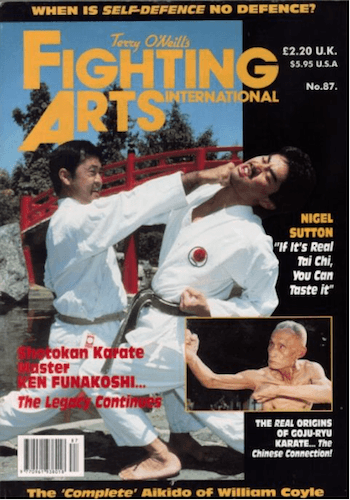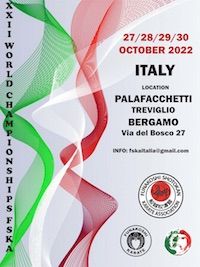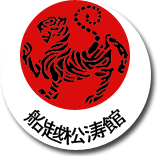
The Legacy
In the Karate world, one could not boast a more famous ancestor than Master Gichin Funakoshi- the man revered as the ‘Father of Japanese Karate’ and the creator of the Shotokan Style. That ore o* – s descendants would become a senior-ranked master of Shotokan Karate is really not that unexpected a turn:-” events…However, for Hawaiian born Kenneth Funakoshi this was not a simple case of following in the j footsteps”. Born in Honolulu, Hawaii on September 4th 1938, Kenneth was aged 10 and attending the Fort Gakuen Japanese Language School, when he got his first taste of the Martial Arts. This was via Arakaki Sensei, a prominent and highly respected Judo master. During High School, his athletic prowess earned him a place on [both the football team and to captaincy of the Territory’s National Swimming Team. (At that time, Hawaii was not| yet a State) .Jan 1956, an athletic scholarship (for swimming) gained him a place at the University of Hawaii and, whilst still continuing Judo training, Kenneth began learning Kenpo—a very aggressive Hawaiian ‘street fighting’ system— under one of its top exponents, Adriano Emporado, It was not until early 1960 — when he “connected” with the art of Shotokan Karate — that Kenneth Funakoshi began to follow the path of his true destiny.
Terry O’Neill
Sensei, I find it quite incredible that you were unaware of the fact that you were a descendant of the great Master Gichin Funakoshi… and that it was only by coincidence that, today, you are continuing the family legacy!
Nevertheless, that is the truth. I had already started training in Shotokan before I realized just whom I was related to. Occasionally I had heard my parents talking of: “Our old cousin, the Karate instructor in Okinawa”, but it meant little to me.
How exactly are you related to him?
I am his fourth cousin, on my father’s side of the family. Both my parents are Okinawan and my father, Yoshio actually practiced Karate in his youth under Gichin Sensei in Okinawa from 1915 to 1925. After then, Master Funakoshi lived in Japan until his
death.
What made you take up Kenpo rather than Karate?
There were no Japanese styles taught in Hawaii at that time, only Kenpo. Then I heard through the grapevine that a Japanese champion was coming to the islands to teach. The JKA (Japan Karate Association) had assigned their first Grand Champion to introduce Shotokan ryu (style/system) to Hawaii. This turned out to be Hirokazu Kanazawa Sensei, a Karate sense/ (teacher) of the highest caliber. At that time, I already held Dan grades in both Judo and Kenpo, and I had been told by the Chito-ryu people that I would retain my Black Belt status if I joined them. However, after seeing Kanazawa Sense! In action, I decided to start at the beginning again, I have never once regretted taking the route I chose. In addition, in fact, this set the standard of top-level instruction that we enjoyed on Hawaii for the next decade.
I believe you were taught personally by senseis: Kanazawa, Mori and Asia?
Yes, I was extremely fortunate in that, for the first 10 years of my Karate career, I had both personal training and general dojo training from all three of these sense!, whom I believe are amongst the
best that the JKA has ever produced…and they were in their prime during their years on Hawaii!
Please tell us a little about each instructor?
Kanazawa Sensei was a great man yet very humble and a real gentleman both inside and outside the dojo. His style of teaching in the early days was slow and easy, Karate was new here and almost every student was a beginner. There was one or two brown and black belts who had been training in Japan while working there, but overall this was a beginner’s class. Kanazawa was very gentle with the children and he attracted students of all ages and nationalities to his dojo. It is interesting that in the early years, the average age of a student was 40 years old; I was seen as a kid. Today most people have stopped training long before they get to that age. Training became far more intense as we learned the system. I seemed to pick up the techniques quite quickly, probably due to my previous training in the martial arts. Kanazawa first introduced us to timing and movement with focus. He was an excellent teacher and I remember that, even during the rest periods, he would ‘constantly practice his techniques in front of the mirrors.
I believe he broke your hand I believe he broke during Kumite?
Yes, we were sparring quite hard one day when he attacked with a yoko-geri kekomi (side thrust kick) —my hand got in the way! He was very fast and agile and used to do many jump kicks. This included kicking the chain on the
top of the kick bag, which hung from the ceiling! He did this regularly. When Kanazawa Sensei was recalled to Japan in 1963, his replacement was Masataka Mori. Mori was a very hard and strict instructor who rarely smiled. Stressing strong kihon (basics) and low stances, and he always hit us with a stick, across the back and legs, if our technique was incorrect. One of his favorite teaching methods, at that time, was to jump on to a student’s back if he was not low enough in the ‘full splits’ position! Despite his harshness, he was always a very honest and sincere man, and I personally enjoyed his hard approach to training. On Saturday mornings, I would teach him English and he would then buy me lunch. We always went horse riding on a Saturday afternoon. By the time he was ready to leave Mori Sensei was far more mellow in his approach to life…Hawaii has that effect on people. When Tetsuhiko Asai Sensei arrived to take over as the resident JKA instructor to Hawaii, he was amazed at the change in Mori, who now sang Hawaiian songs, played the ukulele and even danced the Hula! Asai Sensei was the last of the three instructors sent by the JKA. He was amazingly fast and seemed able to do the unimaginable…performing techniques that other instructors could only dream of doing! Even though he was blind in one eye at that time (a tournament injury that has now been repaired after several operations) he was deadly accurate with his techniques. Asai Sensei, I would describe, as an instructor’s instructor, in addition to which he is a fine gentleman. He enjoyed Hawaii so much that he extended his visa for over four years. The long-range JKA plan for Hawaii was to give it the best possible grounding in Shotokan: – In the first three years, Kanazawa Sensei’s gave us an introduction of Shotokan -ryu to the islands, Mori Sensei continued with strong basics and basic kata, and finally Asai Sensei added the more advanced techniques and forms.
I know you had a long and successful tournament career…could you tell us a little about that period?
I competed for five years in Hawaii and was their Grand Champion for that period—from 1964 to 1968 inclusive. We would train all year for this one tournament. In 1967 and ’68 I placed second in both kata and kumite (fighting) in the All American Karate Federation Championships, run by Hidetaka Nishiyama Sensei. I trained with Nishiyama Sensei for nine months, during which
time he treated me extremely well. I felt that he was preparing me for bigger things but I went back to Hawaii before they came to fruition. I taught at his dojo in Los Angeles and captained one of his kumite teams. Many champions of the day were members of his dojo, including Frank Smith (All-American kumite champion) and James Yabe (All-American kata champion).
You also faced many of the top Japanese fighters—including the famous JKA Champion Hiroshi Shirai—didn’t you?
Yes, that is correct. I first competed in Japan, representing Hawaii, at the 1963 JKA championships My match against Shirai Sensei was in 1964, when sensei’s: Kanazawa, Kase, Shirai and Enoeda stopped off in Hawaii en-route to open dojos in Europe and South Africa. They trained with us and we organized an exhibition match between Hawaii and Japan. Although it was just a ‘friendly’, both sides were of course fighting to win. I fought Shirai Sensei to a draw, with no points scored…whilst Enoeda Sensei broke his opponent’s ribs! In 1965, I captained the Hawaiian Team against the Japan Collegiate Team, just after they had beaten Nishiyama Sensei’s team in America. In preparation for this competition, Mori Sensei had us training twice a day, first at 5.30-7.30 am, then again from 7.30-9.30 pm. During the tournament, the score was even with two wins each. I fought the last match against the Japanese team captain Ozawa. After one minute of fighting, we faced each other for about 30 seconds without moving, just waiting for the other to make a mistake. I ‘felt’ rather than saw his attack coming and at that instant punched gyaku-zuki (reverse punch)…and received ippon (a full point) due to its timing. The final score was Hawaii 3—Japan 2.
I represented Hawaii again at the 1968 JKA Championships in Japan. There were over 1,000 yudansha (black belts) competing in the two day event. On the first day, I won all my fights. The following day I won my first match against Tachibana Sensei but was beaten in the next by lida Sensei. After some close exchanges, he won by waza-ari (a half-point), lida went on to win the Japanese All Styles Karate Championship the following year. We fought Japan again in 1969, in a goodwill match. The Japanese team included Oishi Sensei and Tabata Sensei, two JKA champions. I won my match against Fuji Sensei but overall, Japan won 4-3. In late 1969, when I had become Coach/Instructor to the Hawaiian team, we had another match against those years Japan Collegiate Champions. I suggested that we have a seven-man match, thus allowing the Japanese team to use their reserves. Two of my personal students beat two of their top fighters: A. Sekiguchi beat the Japanese captain, Y. Osaka and G. Sasano beat K. Wada (who became All Japan Champion the following year). Hawaii beat those 5-1, the other fight being a draw.
I know that you have had a long and involved history with the JKA …you were the ‘JKA Chief Instructor to Hawaii’ in 1969, and then in 1984, Nakayama Shihan appointed you JKA Director of the Pacific Region…yet you have now parted from them on two occasions. If it were not too delicate a subject, would you care to explain?
I have no problem with that. After I competed in Japan in 1968, I approached Master Nakayama, on Asai Sensei’s behalf, (at that time Asai was still in Hawaii) with the request that Hawaii report directly to the JKA in Japan, rather than through Nishiyama Sense! In the States. We felt that we would be more comfortable with direct links to Japan and the JKA but Nakayama Sense! Said that, at that time he could not grant my request. Before Asai Sense! Returned to Japan in 1969, he recommended that Tabata sense! Be his successor but it was the decision of the Board of Directors that I be made Chief Instructor to Hawaii. Tabata Sensei was therefore assigned to teach in Mexico City. In June 1975, I resigned from the AAKF (All American Karate Association), breaking links with both Nishiyama and, therefore, unfortunately with the JKA also. I felt that Nishiyama had left me no real alternative. I was not happy with some of the things that were going on, and he would not release the JKA from their
agreement concerning Hawaii and himself. At that time Kanazawa Sense! Was back in Japan continually fighting our case, but to no avail. After my break, many dojos in the USA began joining me, so I travelled there on a monthly basis to teach and grade students.
However, you were then approached to re-affiliate, weren’t you?
In 1984, Takagi Sensei (the former unified JKA’s Technical Secretary), along with sensei’s: Ueki, Tanaka, Asai, Imura and Isaka came to Hawaii. We had lunch at the Pagoda Hotel, and I was offered whatever assistance I needed with respect to re-affiliation to the JKA. That same year I went to Japan as a guest of Asai Sensei and his family. For the two weeks that I was there, we trained every morning at am in his back garden. After showering, we would then travel by train to the JKA Honbu (Headquarters). I trained daily in the instructor’s class, which Asai Sensei taught. One day after training, sensei’s, Asai, Tanaka and myself had a meeting with Master Nakayama. My re-affiliation was discussed and I was then appointed Director of the Pacific Region, reporting directly to Asai Sensei at the JKA. After the meeting, Master Nakayama invited both Asai and myself to be his guests at a small restaurant across from the Honbu, where we ate his favorite seafood soup. By the time I rejoined the JKA, in 1984, the American dojos had become a bit of a problem. Although they still wanted to be affiliated to me, I was responsible for the Pacific Region, not the States. I contacted Asai Sensei about this and he advised me to continue my work with no changes. Shortly after this, I received a telephone call from Okazaki Sensei on the mainland, requesting that all my students in America come under either the jurisdiction of himself or of Nishiyama Sensei. After Master Nakayama passed away, an increasing number of problems arose within the JKA. Therefore, in 1986, I moved to California to be more accessible to my
affiliated dojos in the USA and Mexico, and I left the JKA. This was not a decision that I took lightly, but I did not want to cause Asai Sensei any problems, as I was his ‘responsibility’. I personally want no part in politics. I am simply a Karate instructor who wants to teach Karate. In 1987, after much deliberation, I formed the ‘Funakoshi Shotokan Karate Association’—the name
Funakoshi in the title is out of respect for the founder of our style. I still have great respect for the JKA and have many friends still with them.
Do your two sons follow the Shotokan tradition?
Yes and they are my most loyal students. Fortunately, they are also my best technicians, competitors and instructors.
The words of an extremely proud father…
I am, but also as a Karate instructor descended from Master Gichin Funakoshi, I could not ask for more. My eldest son Kevin is 33 years old and has been training since the age of five, and is now a 5th Dan. He was kata and kumite champion for both the
Association, and the Hawaiian Karate Congress for many years prior to 1983. He also took 1st place in kumite at Ozawa Sensei’s tournament in Las Vegas, in 1984. Kyle is 21 years old and is currently ranked 4th Dan. Like Kevin, he started Karate when he was five years old. He is our Associations National kata and Lightweight kumite champion. I have never forced my sons to train in Karate, but did encourage them to participate in other sports. However, they preferred to train with me…I am very happy with that!


